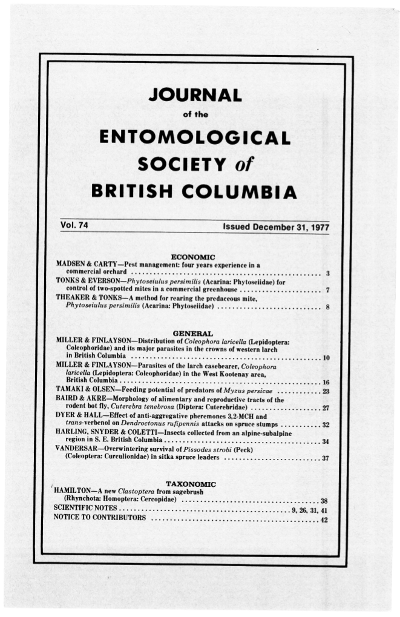<i>Phytoseiulus persimilis</i> (Acarina: Phytoseiidae) for control of two-spotted mites in a commercial greenhouse
Keywords:
<i>Phytoseiulus persimilis</i>, Acarina, Phytoseiidae, two-spotted spider miteAbstract
Natural infestations of the two-spotted spider mite were controlled on green house cucumber by early releases of the predatory mite, <i>Phytoseiulus persimilis</i> Athias-Henriot. Later sporadic mite outbreaks severely damaged some plants and required frequent surveys and repeated predator releases in the greenhouse. However, no mite sprays were required and crop yield was satisfactory.References
Anonymous, 1972. The biological control of cucumber pests. Growers Bull. No. 1. Glasshouse Crops Research Institute. Littlehampton, Sussex.
Chant, D.A. 1961. An experiment on the biological control of Tetranychus telarius L. in a greenhouse using Phytoseiulus persimilis A.H. Canad. Ent. 93:437-443.
Gould, H.J. 1970. Preliminary studies of an integrated control program for cucumber pests and an evaluation of methods of introducing Phytoseiulus persimilis Athias-Henriot for the control of Tetranychus urticae Koch. Ann. appl. Biol. 66:503-513.
Gould, H.J. 1971. Large scale trial of an integrated control programme for cucumber pests on commercial nurseries. Pl. Path. 20:149-156.
Scopes, N.E.A. and W.J. Parr. 1971. Big decision on predator control must be made. Grower 75(13):794-798.
Downloads
Published
Issue
Section
License
Authors who publish with the Journal of the Entomological Society of British Columbia agree to the following terms:
-Authors retain copyright and grant the journal right of first publication with the work simultaneously licensed under a Creative Commons Attribution License that allows others to share the work with an acknowledgement of the work's authorship and initial publication in this journal.
-Authors are able to enter into separate, additional contractual arrangements for the non-exclusive distribution of the journal's published version of the work (e.g., post it to an institutional repository or publish it in a book), with an acknowledgement of its initial publication in this journal.
-Authors are permitted and encouraged to post their work online (e.g., in institutional repositories or on their website) prior to and during the submission process, as it can lead to productive exchanges, as well as earlier and greater citation of published work (See The Effect of Open Access).


